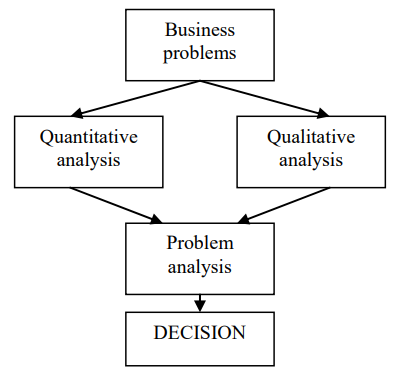Significance of quantitative techniques in the decision making process
Introduction
Quantitative approaches are utilized to aid decision-making in almost every facet of daily life. Managers must apply quantitative methods confidently and reliably to operate effectively in a contemporary business organization, whether a private commercial corporation, a government agency, a state industry, or anything else. Accountants make judgments based on facts about an organization’s financial status. Economists make decisions based on knowledge about the economic environment in which the company works. Customers’ reactions to products and designs are used by marketing personnel to make decisions. Personnel managers make choices based on facts such as the organization’s employee numbers and so on. Such information is becoming increasingly quantitative, and it is clear that managers want a working understanding of the methods and strategies for analyzing and assessing such data. Such analysis, especially business evaluation, cannot be assigned to a specialized statistician or mathematician, who, while skilled at complex numerical analysis, typically have no overall grasp of the commercial importance of such investigation.
The importance of quantitative methods
Quantitative methods have several characteristics, including the following: they use measurable data to produce comparable and useful results, assume alternative plans for achieving objectives, plan data collection, configuration, and elaboration using statistical and econometric stochastic methods, check data reliability, choose appropriate sampling methods, and use estimates carefully. Managers and their supporting information systems must make quick choices that are, hopefully, suitable. Finally, the repercussions of making poor judgments grow more significant and costly, compounding the difficulties. Organizations will suffer substantial consequences if they enter the incorrect markets, produce the wrong products, or provide improper services. All of this indicates that anything that might assist an organization’s management in dealing with the demands and challenges of decision-making should be addressed appropriately. Quantitative approaches give information about a topic or problem and a new way of looking at it that may be beneficial. Naturally, any quantitative analysis will generate data that must be evaluated and combined with other sources. Quantitative approaches are used to solve business problems. The procedure revolves around the decisions that must be taken. The chosen organization’s strategy in terms of future direction, priorities, and activities will significantly impact these. Many variables and data must be examined before making a choice. Techniques can also play an essential part in assisting an option, but they are not adequate in and of themselves. Figure 1 shows how this works.


Figure 1. The decision making process [1]
Different forms of formal mathematics and other types of models have been implemented in quantitative decision-making issues. Network analysis, forecasting (regression, route analysis, and time series), cost-benefit analysis, optimization (linear programming, assignment, and transportation), sensitivity analysis, significance testing, simulation, benchmarking, and overall quality management are used by businesses. The facts, statistics, or quantitative elements of an issue are the focus of quantitative analysis. The decision-making process is aided by a manager’s educational and technical understanding of quantitative methods. A manager who understands quantitative decision-making methods is in a far better position to compare and analyze qualitative and quantitative sources of information or to combine options to make the best judgments feasible.
The decision making process
The following steps are included in the real-world problem-solving process:
1) Recognize the company’s surroundings and unpredictability
2) The existence of autonomous management units
3) A holistic approach to real-life circumstances
4) Scientific Approach Implementation
Understanding that the new reality is exogenously provided, irreversible, and moving at a one-way pace is the first step in processing. While the cost of inactivity may be insurmountably higher than the cost of action today, an open-minded “cost/benefit analysis” overcomes hesitancy and delay and creates synergistic effects over time. Time plays a crucial role in “competitiveness” in an uncertain environment when the probability distributions of the variables are factored into the study.
Conclusions
Modern management is increasingly embracing and utilizing quantitative approaches to help in the decision-making process. The judicious application of the right tools can reduce an otherwise complicated problem to a manageable size. Though there is no such item as an integrated theory of making decisions, the collection of various approaches has been known as “decision theory.” However, suppose these approaches are seen as nothing more than a collection of tools occasionally employed to tackle specific issues. In that case, they will have a significant negative influence.
References
[1] Djordjević, Vera. “The role of quantitative techniques in decision making process.” EKONOMSKI FAKULTET NIŠ (2008): 1.
[2] Murugesan, P. “Importance of quantitative techniques in managerial decisions.” Department of Management Studies (2011).
[3] Gupta, M. P. Quantitative techniques for decision making. PHI Learning Pvt. Ltd., 2006.



 Previous Post
Previous Post